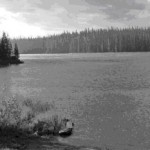Big drops of rain seemed to sizzle as they hit my hot skin during the first thunderstorm in August.
We hadn’t had rain in weeks and temperatures had soared to nearly 40 C, leaving me limp and listless.
Yet, as humans, we have the capability of scrounging up water artificially when we need it. Plants in the wild just wilt and dry out when there’s a drought in this near-desert climate.
I felt rejuvenated as I lifted my face and my arms to feel that rain on my skin, and I’m not unhappy waking in the morning this week to the sound of rain pitter-pattering on the deck outside my window. It’s not just refreshing. it’s life-giving and life-saving.
Mother Nature just saved our bacon. The fields and forests of the Okanagan were becoming tinder dry, reminiscent of the summer of 2003 when I warned in this column that we were on the verge of a devastating forest fire unless the rains came soon.
That was shortly before the Okanagan Mountain Park wildfire was ignited by a chance lightning strike, setting the hills of south Kelowna ablaze. That’s becoming less and less likely as our forest fire fighters pounce every time a bolt of lightning touches earth around here, and now as that earth gets a drenching.
When it becomes as dry as it has this summer, it takes a lot of rain to re-charge groundwater. The first rainfall simply evaporates from the over-heated soil and asphalt.
It takes a lengthy downpour to begin to penetrate the top layer of soil, or to start to run off the forest canopy and reach any of the soil underneath. It takes even longer before water runs off and into streams and reservoirs and lakes, to replenish them.
We’ve been pretty unconcerned about the water resource in the valley over the years. With a rapidly rising human population occurring in recent years, there have been some warnings—particularly during that drought of 2003 when Summerland declared a local state of emergency, banned the watering of lawns and gardens, and reduced agricultural irrigation by 20 per cent because its upland reservoirs were going dry.
The municipality stopped the flow of water down Trout Creek and into Okanagan Lake, despite the fact that would kill trout and prevent kokanee from entering the stream to spawn.
Middle Vernon Creek in Lake Country went dry, and flows in Mission Creek—the largest single contributor of water to Okanagan Lake—dropped alarmingly.
It was a wake-up call for those with authority over water in the Okanagan Basin.
It took a couple of years of soul searching, but eventually, the valley-wide Okanagan Basin Water Board, which was made up of elected representatives from each of the basin’s regional districts, began to talk about broadening its mandate, which up to then, had focussed on controlling milfoil in valley bottom lakes.
In 2006, the board agreed to take on the mandate for leading and coordinating basin-wide water management in the Okanagan.
Since then, it has embarked on the ambitious, but essential, task of assessing water resources in the basin, both above and below the ground. It has tackled the issues of priorities for water management and formed partnerships with all levels of government, including local water utilities and federal researchers, and an enormous body of work is now underway to learn all we can about the Okanagan’s water resource.
It has become clear that water policy and planning in this basin must be integrated so the resource can be husbanded, in order that the disasters of the year 2003 won’t happen all over again.
Currently, the OBWB is reviewing its progress since 2006 because it’s necessary now to gain approval from local government throughout the basin to extend the water management program for another three years; to continue the efforts that are underway to work toward basin-wide, sustainable water management.
In the next two weeks, Anna Warwick Sears, executive director of the OBWB, will appear before regional districts throughout the valley with a proposal to continue the current work of the basin-wide board.
It would be folly for any of them to refuse to support the huge task the OBWB has undertaken and waste the investment of energy, time and money that’s been expended thus far. As well, there should be enthusiastic support for the Okanagan Water Stewardship Council, which advises the OBWB.
This council has done some amazing work, bringing together as it does the expertise of groundwater engineers, fisheries biologists, farmers and foresters, agriculture researchers, professors from a variety of relevant disciplines, health ministry drinking water officers, federal and provincial environment ministry staff, developers, water utilities and the Okanagan Nation Alliance.
Each has brought a unique view to the table, and each has taken away a new view of the water resource in the Okanagan, from every meeting. As a result of the work this 26-member council has done in the past two years, a workshop called One Watershed—One Water will be held Oct. 21 to 23 in Kelowna where an action plan for sustainable water use in the valley will be presented.
It’s taken decades longer than it should have, but it’s exciting to finally see some concrete steps being laid out to take the valley into the future, based on sustainable use of the water resource.

